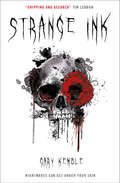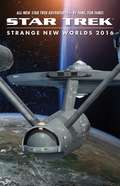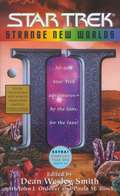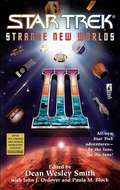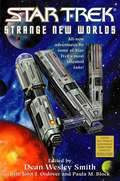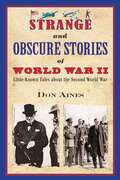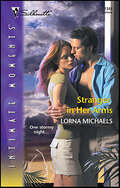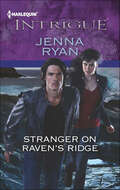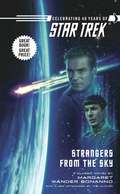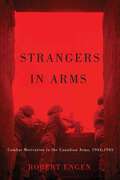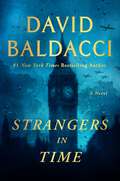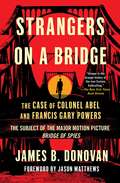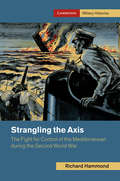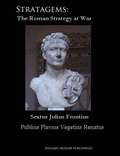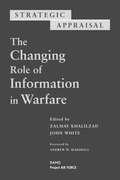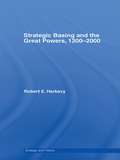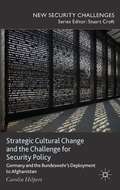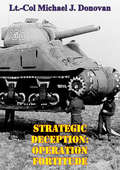- Table View
- List View
Strange Ink
by Gary KembleSpine-chilling horror in the vein of Joe Hill. After moving into a new house, journalist Harry Hendrick wakes up with tattoos that aren't his...When washed-up journalist Harry Hendrick wakes one morning with a hangover and a strange symbol tattooed on his neck, he shrugs it off as a bad night out. But soon more tattoos appear: grisly, violent images which come accompanied by horrific nightmares - so he begins to dig deeper. Harry's search leads him to a sinister disappearance, torment from beyond the grave, and a web of corruption and violence tangled with his own past. One way or another, he has to right the wrongs.
Strange New Worlds 2016 (Star Trek)
by VariousFrom the ordinary to the extraordinary, here are ten all-new fan-created stories embraced by the vision of Star Trek®! When Gene Roddenberry first created this landmark television series fifty years ago, he also tapped a wellspring of human imagination. Viewers were immediately transformed, and over the decades turned the very definition of "fan" on its ear. However, when what was on the screen was simply not enough, fans started writing their own stories...In celebration of the 50th anniversary of Star Trek, here are the electrifying results of the 2016 Strange New Worlds writing contest--the best fan-created stories by new writers such as: Derek Tyler Attico, Neil Bryant, Chris Chaplin, John Coffren, Nancy Debretsion, Kelli Fitzpatrick, Roger McCoy, Kristen McQuinn, Gary Piserchio & Frank Tagader, and Michael Turner. By the fans, and for the fans. Boldly going where no one has gone before.
Strange New Worlds II: Star Trek All Series (Star Trek)
by Dean Wesley Smith John J. Ordover Paula M. BlockAll-new adventures by some of Star Trek's most talented fans!Our first Strange New Worlds competition drew thousands of submissions and Strange New Worlds II drew even more. From this mountain of astounding stories, these few, written exclusively by brand-new authors, were selected for their originality and style. These tales rocket across the length and breadth of Federation time and space, from when Captain Kirk explored the galaxy on the first Starship Enterprise™ through Captain Picard's U.S.S. Enterprise™ NCC-1701-D and Captain Sisko's Deep Space Nine™ to Captain Janeway's Starship Voyager™, with many fascinating stops along the way. Find out what happens in the Star Trek universe when fans—like you—take the helm!
Strange New Worlds III
by Dean Wesley Smith John J. Ordover Paula M. BlockBack by popular demand -- again! Our third anthology featuring original Star Trek®, Star Trek: The Next Generation®, Star Trek: Deep Space Nine®, and Star Trek: Voyager® stories written by Star Trek fans, for Star Trek fans! Each Strange New Worlds competition draws a greater response than the last. The final selections gathered here were chosen from an overwhelming number of entries by virtue of their originality and style. With wit, compassion, and an affection for all things Star Trek, these brand-new authors take us where Star Trek has never gone before. Their tales rocket across the length and breadth of Federation time and space, from when Captain Kirk explored the galaxy on the first Starship Enterprise , through Captain Picard's U.S.S. Enterprise 1701-D and Captain Sisko's Deep Space Nine , to Captain Janeway's Starship Voyager , with many more fascinating stops along the way. Find out what happens in the Star Trek universe when fans -- like you -- take the helm!
Strange New Worlds III
by Dean Wesley Smith John J. Ordover Paula M. BlockBack by popular demand -- again! Our third anthology featuring original Star Trek®, Star Trek: The Next Generation®, Star Trek: Deep Space Nine®, and Star Trek: Voyager® stories written by Star Trek fans, for Star Trek fans! Each Strange New Worlds competition draws a greater response than the last. The final selections gathered here were chosen from an overwhelming number of entries by virtue of their originality and style. With wit, compassion, and an affection for all things Star Trek, these brand-new authors take us where Star Trek has never gone before. Their tales rocket across the length and breadth of Federation time and space, from when Captain Kirk explored the galaxy on the first Starship Enterprise , through Captain Picard's U.S.S. Enterprise 1701-D and Captain Sisko's Deep Space Nine , to Captain Janeway's Starship Voyager , with many more fascinating stops along the way. Find out what happens in the Star Trek universe when fans -- like you -- take the helm!
Strange New Worlds IV: Strange New Worlds (Star Trek)
by Dean Wesley SmithAll-new adventures by some of Star Trek's most talented fans!In the fourth year of its ongoing mission, the Strange New Worlds writing competition has once again sought out exciting new voices and imaginations among Star Trek's vast galaxy of fans. After scanning countless submissions for signs of style and originality, the judges are proud to report that the universe of amazing Star Trek writers just keeps expanding. Strange New Worlds IV features more than a dozen never-before-published stories spanning the twenty-third and twenty-fourth centuries, from the early days of James T. Kirk and his crew to the later generations of Captains Picard, Sisko, and Janeway. These memorable new tales explore and examine the past and future of Star Trek from many different perspectives. Join Strange New Worlds in its thrilling quest to uncover the most compelling Star Trek action this side of the Galactic Barrier!
Strange and Obscure Stories of World War II: Little-Known Tales about the Second World War
by Don AinesHere are overlooked or forgotten tales from the world's greatest conflict. These are stories of courage, daring, and stupidity, some of which would challenge the imaginations of Hollywood scriptwriters. Some of the many true tales that author Donald Aines recounts include: • He would never be cast as a dashing war hero, but a cast member of "The Addams Family" television show volunteered for one of the most dangerous jobs the Army Air Force had to offer. • The US Navy's deadliest submarine claimed an unexpected victim with its last torpedo, and led to one of the war's most harrowing tales of survival. • Bob Hoover's escape from a German stalag would have made a great movie. • British commando "Mad Jack" Churchill earned his nickname, arming himself to fight a 20th century war with a 15th century attitude and weapons. • The Germans and Japanese wasted precious resources developing weapons more dangerous to the users than their enemies. • The GI who stole the voices of his victims, and other Allied and Axis serial killers. Within the pages of Strange and Obscure Stories of World War II,the reality of war trumps fiction.
Stranger in Her Arms
by Lorna MichaelsWhen the doorbell rang in the middle of adevastating summer storm, Christy Matthewsfound a bruised, rain-battered stranger on herporch. While the wind howled, she tended tohis injuries. Stranded with him in her islandsanctuary, she found it impossible to ignore hisrugged sensuality…and the growing desire tolose herself in his embrace.No wallet. No driver's license. Not a clue to hisidentity. Yet this beautiful healing angel trustedhim to keep her safe. With a killer on the loose,protecting Christy became his most vital mission,but the passion she awakened could thrust themboth into harm's way. He had no memory ofyesterday, but he'd risk everything to lie in herarms today, tomorrow and always….
Stranger on Raven's Ridge
by Jenna RyanLocal legend said that sacrifice was the truest love of all...Returning to her ancestral home, Raven Blume needed a new start. So she opened a medical clinic in order to escape the danger that had torn her life apart-and claimed her husband's life. But local legend spoke of a ghost, a reincarnated soul haunting her house, the one high up on Raven's Ridge....Lurking within the mist was the man she thought dead. Aidan McInnis remained out of sight, venturing close enough to touch his Raven, but not daring to. The moment he did, he put a target on her back. Time was running out and Raven was quickly becoming familiar with danger. Aidan would die again if he had to-especially if it was the only way to protect her.
Strangers From The Sky: Strangers From The Sky (Star Trek: The Original Series)
by Margaret Wander BonannoThe planets Earth and Vulcan experience a mysterious first contact in this fascinating Star Trek novel featuring the crew of the U.S.S. Enterprise.Years before the formal first contact between Earth and another planet&’s inhabitants, a Vulcan space vessel crash landed in the South Pacific, forcing humanity to decide whether to offer the hand of friendship, or the fist of war. Complicating matters is a second visitation: a group of people from two hundred years in the future, who serve on a starship called Enterprise. Discover the astonishing truth about this heretofore unknown first contact and the nightmares that plague Admiral James T. Kirk. Dreams of his dead comrades, of his earliest days aboard the U.S.S. Enterprise, and of a forgotten past in which he somehow changed the course of history and destroyed the Federation before it began.
Strangers in Arms: Combat Motivation in the Canadian Army, 1943-1945
by Robert EngenWhy do soldiers fight? What keeps them going? What compels them to face death when their long-time comrades have fallen around them? Strangers in Arms addresses these questions in a groundbreaking study of the behaviour, morale, and motivations of Canadian infantrymen on the front lines of the Second World War. Canada’s army has long faced intense criticism for its combat performance during the war, and Canada’s official history has presented Canadian soldiers as deficient, inexperienced, and unprepared in comparison with their enemies. Questioning entrenched views, Robert Engen explores a trove of contemporaneous documents to create a remarkable new portrait of Canadians at war. Rather than the popular "band of brothers" image of soldier cohesion in battle, he finds staggering casualty rates and personnel turmoil that left Canadian infantrymen often working with and fighting beside men they hardly knew. Yet these strangers in arms continued to fight - effectively and in good spirits - against a tenacious and deadly enemy, triumphing in the face of heartrending loss and sacrifice. Challenging old narratives about the Canadian soldier and supported by cutting-edge empirical and qualitative research, Strangers in Arms crafts a new understanding of what happens at the sharp end of battle.
Strangers in Arms: Combat Motivation in the Canadian Army, 1943-1945
by Robert EngenA penetrating study of why soldiers fight and what sustained Canadians in battle during the Second World War.
Strangers in Time: A World War II Novel
by David BaldacciFrom the #1 New York Times bestselling author of A Calamity of Souls comes David Baldacci’s newest novel, set in London in 1944, about a bereaved bookshop owner and two teenagers scarred by the Second World War, and the healing and hope they find in one another. <p> Fourteen-year-old Charlie Matters is up to no good, but for a very good reason. Without parents, peerage, or merit, he steals what he needs, living day-to-day until he’s old enough to enlist to fight the Germans. After barely surviving the Blitz, Charlie knows there’s no telling when a falling bomb might end his life. <p> Fifteen-year-old Molly Wakefield has just returned to a nearly unrecognizable London. One of millions of children to have been evacuated to the countryside Molly has been away from her home for nearly five years. Her return, however, is not the homecoming she’d hoped for as she’s confronted by a devastating reality: neither of her parents are there. <p> Without guardians and stability, Charlie and Molly find an unexpected ally and protector in Ignatius Oliver, and solace at his bookshop, The Book Keep. Mourning the recent loss of his wife, Ignatius forms a kinship with both children, and in each other they rediscover the spirit of family each has lost. But Charlie’s escapades in the city have not gone unnoticed, and someone’s been following Molly since she returned to London. And Ignatius is harboring his own secrets, which could have terrible consequences for all of them. <p> As bombs continue to bear down on the city, Charlie, Molly, and Ignatius learn that while the perils of war rage on, their coming together and trusting one another may be the only way for them to survive. <b>New York Times Bestseller</b>
Strangers on a Bridge: The Case of Colonel Abel and Francis Gary Powers
by James DonovanThe #1 New York Times bestseller and subject of the acclaimed major motion picture Bridge of Spies directed by Steven Spielberg, starring Tom Hanks as James B. Donovan. Originally published in 1964, this is the &“enthralling…truly remarkable&” (The New York Times Book Review) insider account of the Cold War spy exchange—with a new foreword by Jason Matthews, New York Times bestselling author of Red Sparrow and Palace of Treason.In the early morning of February 10, 1962, James B. Donovan began his walk toward the center of the Glienicke Bridge, the famous “Bridge of Spies” which then linked West Berlin to East. With him, walked Rudolf Ivanovich Abel, master spy and for years the chief of Soviet espionage in the United States. Approaching them from the other side, under equally heavy guard, was Francis Gary Powers, the American U-2 spy plane pilot famously shot down by the Soviets, whose exchange for Abel Donovan had negotiated. These were the strangers on a bridge, men of East and West, representatives of two opposed worlds meeting in a moment of high drama. Abel was the most gifted, the most mysterious, the most effective spy in his time. His trial, which began in a Brooklyn United States District Court and ended in the Supreme Court of the United States, chillingly revealed the methods and successes of Soviet espionage. No one was better equipped to tell the whole absorbing history than James B. Donovan, who was appointed to defend one of his country’s enemies and did so with scrupulous skill. In Strangers on a Bridge, the lead prosecutor in the Nuremburg Trials offers a clear-eyed and fast-paced memoir that is part procedural drama, part dark character study and reads like a noirish espionage thriller. From the first interview with Abel to the exchange on the bridge in Berlin—and featuring unseen photographs of Donovan and Abel as well as trial notes and sketches drawn from Abel’s prison cell—here is an important historical narrative that is “as fascinating as it is exciting” (The Houston Chronicle).
Strangling the Axis: The Fight for Control of the Mediterranean during the Second World War (Cambridge Military Histories)
by Richard HammondThis is a major reassessment of the causes of Allied victory in the Second World War in the Mediterranean region. Drawing on a unique range of multinational source material, Richard Hammond demonstrates how the Allies' ability to gain control of the key routes across the sea and sink large quantities of enemy shipping denied the Axis forces in North Africa crucial supplies and proved vital to securing ultimate victory there. Furthermore, the sheer scale of attrition to Axis shipping outstripped their industrial capacity to compensate, leading to the collapse of the Axis position across key territories maintained by seaborne supply, such as Sardinia, Corsica and the Aegean islands. As such, Hammond demonstrates how the anti-shipping campaign in the Mediterranean was the fulcrum about which strategy in the theatre pivoted, and the vital enabling factor ultimately leading to Allied victory in the region.
Stratagems: The Roman Strategy at War
by Vincent W Rospond Sextus Julius Frontius Pubius Flavius Vegetius RenatiusStratagems: The Roman Strategy at War is a combination of two ancient Roman texts, Stratagems by Sextus Julius Frontius from the first century AD and Concerning Military Matters by Publius Flavius Vegetius Renatius from the fourth century AD. These classic surviving texts cover examples of ancient strategy for use by generals as well as the organization of the army in the later stages of the Empire.
Strategic Air Power in Desert Storm (Studies in Air Power #Vol. 12)
by John Andreas OlsenIn response to the Iraqi invasion of Kuwait on the second of August 1990, a small group of air power advocates in the Pentagon proposed a strategic air campaign - "Operation Desert Storm" designed to drive the Iraqi army from Kuwait by a sustained effort against the major sources of Iraqi national power. John Andreas Olsen provides a coherent and comprehensive examination of the origins, evolution and implementation of this campaign. His findings derive from official military and political documentation, interviews with United States Air Force officers who were closely involved with the planning of the campaign and Iraqis with detailed knowledge and experience of the inner workings of the Iraqi regime.
Strategic Analysis Of U.S. Special Operations During The Korean Conflict
by Major Steve A. FondacaroThis study analyzes the strategic effectiveness of special operations conducted by the Far East Command (FECOM) and the Central Intelligence Agency (CIA) in Korea during the Korean Conflict from 1950 to 1953. Each organization's effectiveness is determined by examining the areas of strategy, organization and operations. Special operations as defined in Joint Chiefs of Staff Publication Number 2, Unified Action Armed Forces (UNAAF) was the standard by which operations were selected for examination. The study answers four questions: 1) What were the U.N. Command strategic objectives within the Korean theater, and how did these change? , 2) How these changing strategic objectives development and coordination of special operations objectives, forces and headquarters?, 3) What did U.S. special operations in Korea accomplish strategically? 4) What conclusions can be drawn from U.S. special operations forces' effectiveness or ineffectiveness in Korea?FECOM special operations were limited to partisan operations and psychological operations. The partisans consisted of anti-communist North Koreans organized and led by U.S. cadre beginning in January, 1951. Psychological operations were conducted continuously from July, 1950 by a separate staff element whose capabilities expanded dramatically during the course of the conflict. CIA operations within Korea consisted of intelligence gathering and special (or covert) activities controlled from headquarters in Japan. CIA operations remained autonomous of FECOM control throughout the conflict. The control issue was the source of bureaucratic conflict that inhibited operational coordination between FECOM and CIA throughout the conflict.
Strategic Appraisal: The Changing Role of Information in Warfare
by David R. Howell Tom Latourrette Barbara Raymond David E. Mosher Lois M. Davis Zalmay KhalilzadAdvances in information technology have led us to rely on easy communication and readily available information--both in our personal lives and in the life of our nation. For the most part, we have rightly welcomed these changes. But information that is readily available is available to friend and foe alike; a system that relies on communication can become useless if its ability to communicate is interfered with or destroyed. Because this reliance is so general, attacks on the information infrastructure can have widespread effects, both for the military and for society. And such attacks can come from a variety of sources, some difficult or impossible to identify. This, the third volume in the Strategic Appraisal series, draws on the expertise of researchers from across RAND to explore the opportunities and vulnerabilities inherent in the increasing reliance on information technology, looking both at its usefulness to the warrior and the need to protect its usefulness for everyone. The Strategic Appraisal series is intended to review, for a broad audience, issues bearing on national security and defense planning.
Strategic Autonomy and Economic Power: The Economy as a Strategic Theater (Routledge Advances in Defence Studies)
by Vitor BentoThis book examines the effect of economic power on a state’s strategic autonomy. Strategic autonomy is a fundamental condition for the availability of strategic options in the interaction of states. This book provides the first clear operational definition of the concept and offers an analysis of the relevance of the national economy to strategic autonomy. The main sources of economic power – size of the economy, position in trade and technological networks, savings, wealth, and finance – and their impact on strategic autonomy are analyzed in depth. The strategic governance of the national economy is also addressed as a way of ensuring that national economic power can work as strategic power for a country, providing it with strategic autonomy. The strategies pursued by China – which in under four decades has gone from an underdeveloped state to the main challenger of the dominant world power – and Germany – which, despite being defeated in World War II, having no nuclear weapons and having chosen to be a "civilian power", became the dominant power in Europe – are analyzed in depth, as two paradigmatic examples of the theory developed by the book. This book will be of much interest to students of strategic studies, economics, foreign policy and International Relations.
Strategic Basing and the Great Powers, 1200-2000 (Strategy And History Ser.)
by Robert E. HarkavyThis is the first book to survey the evolution of the strategic basing systems of the great powers, covering an 800-year span of history, from the Mongol dynasty to the era of the US empire. Robert E. Harkavy details the progression of strategic basing systems and power projection, from its beginnings at a regional level to its current global reach
Strategic Cultural Change and the Challenge for Security Policy
by Carolin HilpertFor more than a decade, international troops have been deployed to Afghanistan. Out of all NATO members, this mission was the most difficult for Germany that had thus far never engaged in combat and offensive military activities. This book analyses how Germany's experiences in Afghanistan have changed the country's strategic culture.
Strategic Culture and Violent Non-State Actors: A Comparative Study of Salafi-Jihadist Groups (Contemporary Terrorism Studies)
by Edward D. LastThis book applies strategic culture concepts to violent non-state actors (VNSAs) in a comparative analysis. In recent years, Al-Qaida in the Islamic Maghreb (AQIM) has become notorious for kidnapping Western hostages in north-western Africa and for its role in the short-lived Islamist takeover of Mali. The group, formerly known as the Salafist Group for Preaching and Combat, rebranded itself as an Al-Qaida franchise in 2007, leading to speculation of a change from its Algeria-centric agenda to an anti-Western one. This study compares and contrasts the ideas and behaviour of these two groups, using a strategic-cultural approach, and finds that, despite some commonalities, AQIM has a distinct strategic culture from Al-Qaida central, thereby debunking the notion of Al-Qaida as a monolithic movement. This is the first comparative analysis of violent non-state actors to employ a strategic-cultural approach and the first such study on AQIM. While strategic culture has traditionally been applied to states, this work adds to the emerging literature applying such approaches to non-state armed groups, and employs a novel conception of strategic culture consisting of narratives and practices. This book will be of much interest to students of strategic culture, political violence, Middle Eastern politics and Security Studies in general.
Strategic Culture and Ways of War (Cass Military Studies)
by Lawrence SondhausA much-needed survey and synopsis of literature on strategic culture and ways of war. It clearly shows how national strategies and approaches to warfare are, to a significant extent, culturally determined. The concept of national ‘ways of war’ dates from the 1930s, when Basil H. Liddell Hart theorized that there was a ‘British Way in Warfare’. The concept of "strategic culture" dates from the 1970s, when Jack Snyder introduced it to explain why leaders of the Soviet Union did not behave according to rational choice theory. These ideas have gained wide acceptance among historians of international politics and warfare, and remain controversial for political scientists seeking general or universal theoretical understanding of such subjects. Because political scientists have focused on strategic culture and historians on ways of war, this work will greatly benefit both audiences and provide each with valuable exposure to the ideas of the other.
Strategic Deception: OPERATION FORTITUDE
by Lt.-Col Michael J. DonovanThe Allied leaders decided to conduct the cross-channel invasion of Hitler's Fortress Europe in the first half of 1944 during the Tehran Conference held in November 1943. To support this invasion they also decided to implement a comprehensive deception campaign given the cover name BODYGUARD. The goal of BODYGUARD was to deceive Hitler and his senior military commanders about the location and timing of Allied offensive actions. Under the BODYGUARD umbrella, operation FORTITUDE was specifically designed to support the invasion of Normandy. FORTITUDE consisted of two primary operations. FORTITUDE-NORTH was designed to convince the Germans that the Allied invasion in 1944 would come through Norway and Sweden vice France. FORTITUDE-SOUTH was developed to convince Hitler and his staff that the primary invasion site in France would be Pas de Calais and other potential invasion sites, such as Normandy, were only diversions. The BODYGUARD and associated FORTITUDE operations were quite successful in fixing German forces, causing reserves to be committed piecemeal and basically paralyzing Hitler's decision making ability during the time of the Normandy landings and for weeks afterwards. The principles of current joint deception doctrine were applicable and utilized by the deception planners of General Eisenhower's staff long before the current Joint doctrine (Joint Publication 3-58, Joint Doctrine for Military Deception) was ever written.
